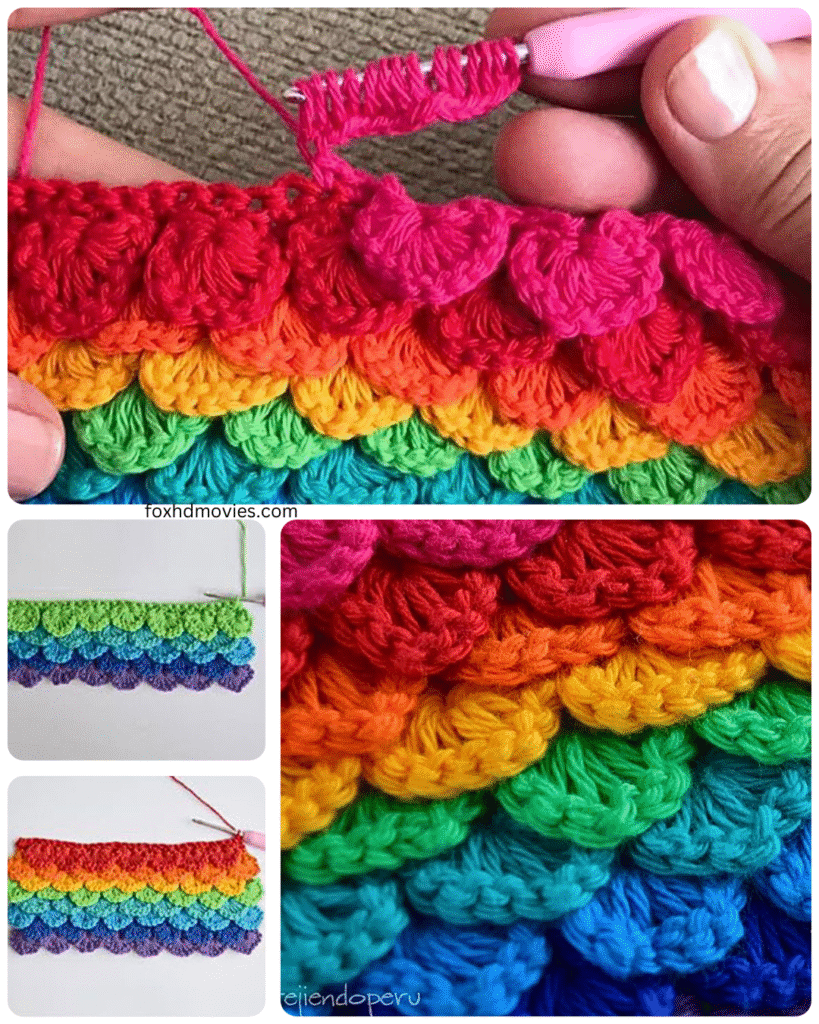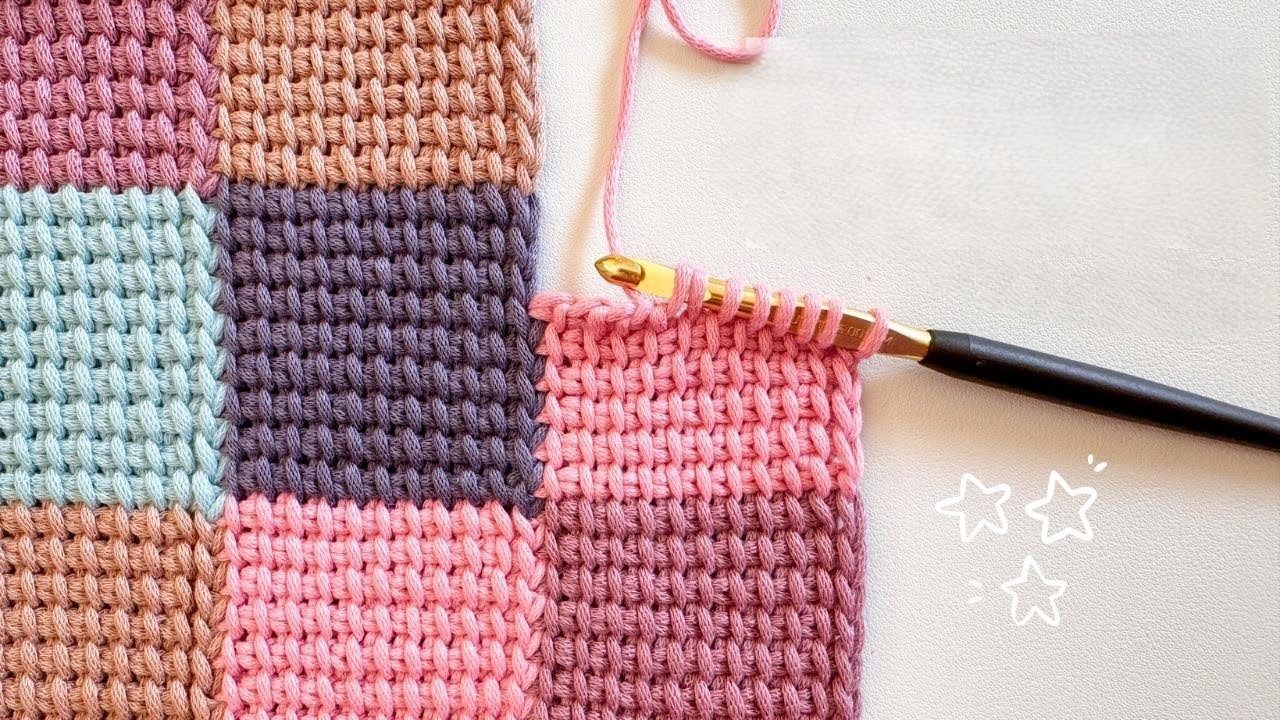
Roar into the world of textured crochet with the mesmerizing Crocodile Stitch! This unique technique creates scales or petals that pop off your work, adding incredible dimension and visual interest to blankets, scarves, bags, and more. While it might look intimidating at first glance, breaking it down step-by-step reveals a surprisingly manageable and utterly captivating stitch.
Get ready to add some serious texture to your projects! This blog post will walk you through the Crocodile Stitch in detail, providing you with the foundation to create stunning, scale-like designs.

What You’ll Need:
- Worsted Weight Yarn: This stitch really shines with a yarn that has good stitch definition. The amount will depend on your project.
- Crochet Hook: Choose a hook size appropriate for your yarn (usually around a 5.0 mm or H/8 hook for worsted weight).
- Scissors: For snipping your yarn.
- Yarn Needle: For weaving in ends.
Understanding the Anatomy of a Scale:
The Crocodile Stitch isn’t a single stitch but rather a combination of stitches worked over two double crochet (dc) posts. Each “scale” you see is formed by working several double crochet stitches down one dc post and then several more up the adjacent dc post. These sets of double crochets are then joined at the top to create the characteristic pointed or rounded shape.
Video tutorial
The Basic Pattern: Creating Rows of Scales
Let’s break down the fundamental steps to create rows of these eye-catching scales.
Foundation Row:
- Chain a multiple of 6 + 3. This multiple of 6 will determine how many “sets” of scales you’ll have across. The extra 3 chains are for the turning chain.
- Double crochet (dc) in the 4th chain from the hook and in each chain across. Turn. (You’ll have a row of double crochet stitches).
Row 1 (Base Row for Scales):
- Chain 3 (counts as the first dc). Skip the next 2 dc stitches. Double crochet (dc) in the next dc. Chain 3, skip the next 2 dc stitches, double crochet (dc) in the next dc. Repeat from * to the end of the row. Turn. You’ll have a row of dc stitches separated by chain-3 spaces.
Row 2 (Creating the First Row of Scales):
- Chain 1, turn. Slip stitch (sl st) in the first dc.
- *Chain 3. Now, you’ll work around the next dc post (the one before the chain-3 space). Yarn over, insert your hook around the post from front to back to front again, yarn over, pull up a loop, yarn over, pull through two loops (first dc made). Repeat this 4 more times (total of 5 dc worked down the post).
- Without turning your work, now work around the next dc post (the one after the chain-3 space) in the same way: Yarn over, insert your hook around the post from front to back to front again, yarn over, pull up a loop, yarn over, pull through two loops (first dc made). Repeat this 4 more times (total of 5 dc worked up the post).
- Slip stitch (sl st) in the top of the dc that comes after the second dc post you just worked around.*
- Repeat from * to the end of the row. Your last scale will be worked around the last two dc posts. Chain 3, and slip stitch into the top of the turning chain from the previous row. Turn.

Row 3 (Base Row for the Next Set of Scales):
- Chain 3 (counts as the first dc). Double crochet (dc) in the top of the first “scale” (the point where the two sets of 5 dc are joined). Chain 3, double crochet (dc) in the top of the next “scale”. Repeat from * to the end of the row. Turn. You’ll have another row of dc stitches separated by chain-3 spaces, offset from the previous base row.
Repeating the Pattern:
You will now repeat Row 2 and Row 3 to continue building your Crocodile Stitch fabric.
- Even-numbered rows (like Row 2): Create the scales, working around the dc posts from the previous base row.
- Odd-numbered rows (like Row 3): Create the base row for the next set of scales, working dc stitches into the tops of the scales from the previous row and creating chain-3 spaces.
Visualizing the Offset:
Notice how the base rows (Row 1 and Row 3) are offset. This is what creates the staggered appearance of the scales. The scales in one row will “nestle” into the spaces between the scales in the previous row.
Tips and Variations:
- Scale Shape: You can adjust the number of double crochet stitches worked on each post to alter the shape and fullness of the scales. Try 4 dc on each side for a flatter scale or 6 for a more dramatic curl.
- Color Changes: Introduce color changes every row or within the scales themselves for a vibrant and eye-catching effect.
- Rounded Scales: Instead of a sharp point at the top of the scale, you can work a chain (e.g., chain 2 or 3) before the final slip stitch to create a more rounded top.
- Working in the Round: The Crocodile Stitch can also be adapted for working in the round, which is fantastic for projects like boot cuffs or decorative rounds. The principle remains the same, but the joining and turning will differ.
- Spacing: Experiment with the number of skipped stitches in the base rows to create different densities of scales.

Troubleshooting Tips:
- Tight Scales: If your scales are pulling too tightly, try using a slightly larger hook or working your double crochet stitches with a looser tension.
- Loose Scales: If your scales are too floppy, try using a smaller hook or working your double crochet stitches with a tighter tension.
- Counting: Keep careful track of your stitches, especially the double crochets worked on each post, to ensure consistent scale formation.
Bringing Your Dragon Scales to Life:
The Crochet Crocodile Stitch opens up a world of creative possibilities. Imagine:
- Dragon Scale Blankets: Cozy and textured blankets that look truly unique.
- Crocodile Stitch Boot Cuffs: Stylish and warm leg warmers with a distinctive flair.
- Scale-Textured Bags: Eye-catching clutches or tote bags with a tactile surface.
- Decorative Edgings: Add a dramatic border to scarves, shawls, or even home decor items.
- Fantasy-Inspired Creations: Perfect for making dragon toys, mermaid tails, or other mythical creatures.
Share Your Scaly Adventures!
I hope this detailed guide has empowered you to tackle the Crochet Crocodile Stitch. Don’t be afraid to experiment and have fun with this captivating technique.


